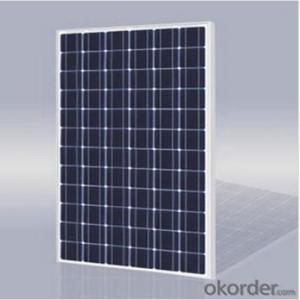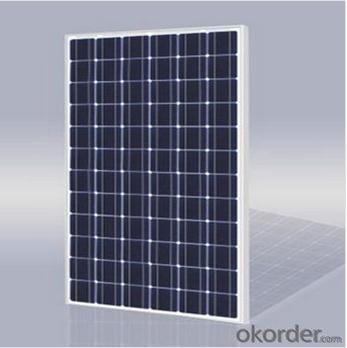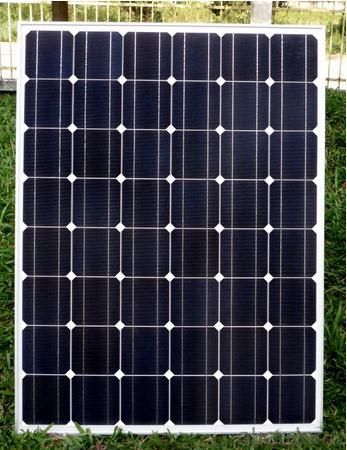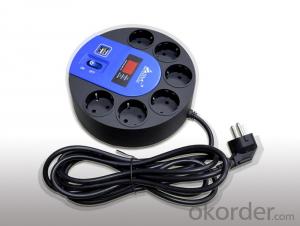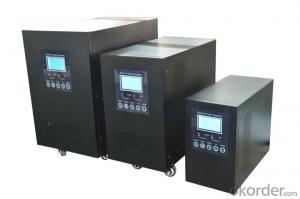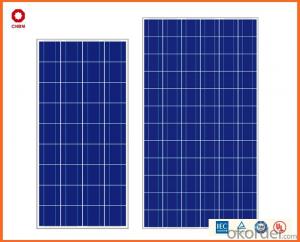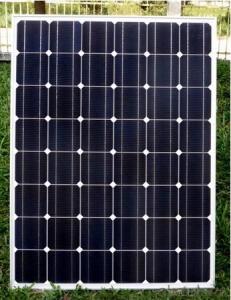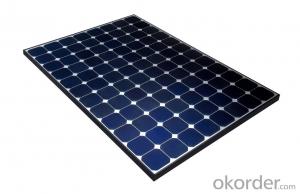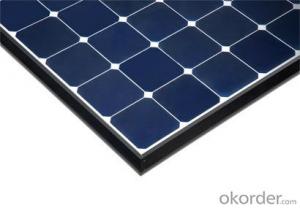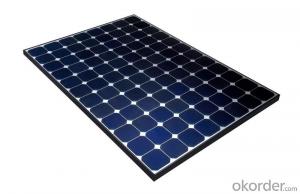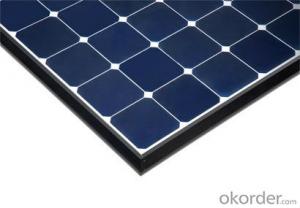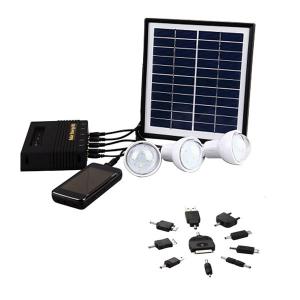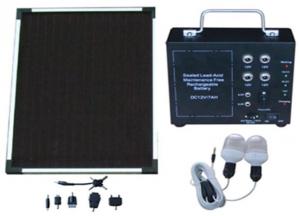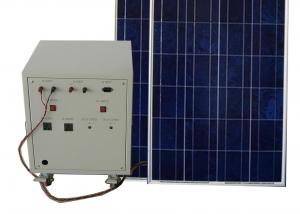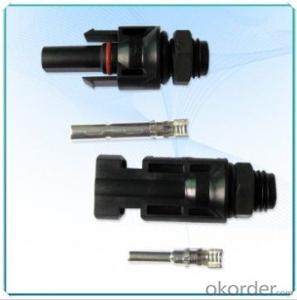Passive Solar Energy Systems CNBM On Grid System 7000W with Certificate UL TUV CE
- Loading Port:
- Shanghai
- Payment Terms:
- TT OR LC
- Min Order Qty:
- 100 watt
- Supply Capability:
- 1000 watt/month
OKorder Service Pledge
OKorder Financial Service
You Might Also Like
Specification
CNBM On Grid System 7000W with Certificate UL TUV CE
Product description
They range from small residential and commercial rooftop systems to large utility-scale solar power stations. Unlike stand-alone power systems, a grid-connected system rarely includes an integrated battery solution, as they are still very expensive. When conditions are right, the grid-connected PV system supplies the excess power, beyond consumption by the connected load, to the utility grid.
Connection of the photovoltaic power system can be done only through an interconnection agreement between the consumer and the utility company. The agreement details the various safety standards to be followed during the connection.[4]
Solar energy gathered by photovoltaic solar panels, intended for delivery to a power grid, must be conditioned, or processed for use, by a grid-connected inverter. Fundamentally, an inverter changes the DC input voltage from the PV to AC voltage for the grid. This inverter sits between the solar array and the grid, draws energy from each, and may be a large stand-alone unit or may be a collection of small inverters, each physically attached to individual solar panels. See AC Module. The inverter must monitor grid voltage, waveform, and frequency. One reason for monitoring is if the grid is dead or strays too far out of its nominal specifications, the inverter must not pass along any solar energy. An inverter connected to a malfunctioning power line will automatically disconnect in accordance with safety rules, for example UL1741, which vary by jurisdiction. Another reason for the inverter monitoring the grid is because for normal operation the inverter must synchronize with the grid waveform, and produce a voltage slightly higher than the grid itself, in order for energy to smoothly flow outward from the solar array.
Solar modules use light energy (photons) from the sun to generate electricity through the photovoltaic effect. The majority of modules use wafer-based crystalline silicon cells or thin-film cells based on cadmium telluride or silicon. The structural (load carrying) member of a module can either be the top layer or the back layer. Cells must also be protected from mechanical damage and moisture. Most solar modules are rigid, but semi-flexible ones are available, based on thin-film cells.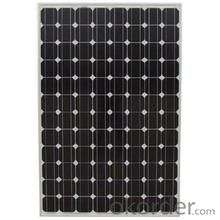
Application
Industrial
Commercial
Residential
Feature
Residential, grid-connected rooftop systems which have a capacity more than 10 kilowatts can meet the load of most consumers.[2] They can feed excess power to the grid where it is consumed by other users. The feedback is done through a meter to monitor power transferred. Photovoltaic wattage may be less than average consumption, in which case the consumer will continue to purchase grid energy, but a lesser amount than previously. If photovoltaic wattage substantially exceeds average consumption, the energy produced by the panels will be much in excess of the demand. In this case, the excess power can yield revenue by selling it to the grid. Depending on their agreement with their local grid energy company, the consumer only needs to pay the cost of electricity consumed less the value of electricity generated. This will be a negative number if more electricity is generated than consumed.[3] Additionally, in some cases, cash incentives are paid from the grid operator to the consumer.
Packaging
With carton and box
- Q: Can solar energy systems be used in commercial agriculture?
- Yes, solar energy systems can be used in commercial agriculture. Solar panels can be installed on agricultural buildings or in open fields to generate clean and renewable energy. This energy can power various agricultural operations such as irrigation systems, crop drying, and greenhouse heating. Solar energy systems offer cost savings, reduce reliance on fossil fuels, and contribute to sustainable farming practices.
- Q: Can a solar energy system be installed on a gas station or convenience store?
- A gas station or convenience store can indeed have a solar energy system installed. In fact, many of these establishments have already taken this step to lower their energy expenses and support sustainability. The solar panels can be placed on the roofs of these buildings or in nearby open areas. By doing so, these systems can produce electricity to power the store's lighting, refrigeration systems, and other electrical devices. Furthermore, any excess electricity generated by the solar panels can be redirected into the grid. This allows the gas station or convenience store to earn credits or income through net metering or feed-in tariff initiatives. By installing a solar energy system, these businesses not only reduce their energy bills, but also demonstrate their dedication to renewable energy and minimize their carbon emissions.
- Q: How does the efficiency of solar panels vary across different panel technologies?
- The efficiency of solar panels can vary significantly across different panel technologies. There are several types of solar panels available in the market, each with its unique characteristics and efficiency levels. Firstly, monocrystalline solar panels are known for their high efficiency. These panels are made from a single crystal structure, resulting in a uniform appearance. Monocrystalline panels have the highest efficiency rates, typically ranging from 15% to 22%. The uniform crystal structure allows for better electron flow, maximizing the conversion of sunlight into electricity. On the other hand, polycrystalline solar panels have a lower efficiency compared to monocrystalline panels. These panels are made from multiple silicon crystals, which creates a less uniform appearance. Polycrystalline panels generally have an efficiency range of 13% to 16%. The presence of multiple crystals can cause electron flow to be less efficient, resulting in a slightly lower conversion rate. Another type of solar panel technology is thin-film panels. Thin-film solar panels are made by depositing thin layers of photovoltaic material onto a substrate. These panels have the lowest efficiency rates among the different technologies, typically ranging from 10% to 12%. However, thin-film panels have the advantage of being lightweight, flexible, and less expensive to produce, making them suitable for certain applications where efficiency is not the primary concern. Furthermore, there are emerging technologies like bifacial solar panels and multi-junction solar cells. Bifacial panels have the ability to capture sunlight from both sides, increasing their overall efficiency. Multi-junction solar cells use multiple layers of semiconductors to capture a broader spectrum of light, enabling higher efficiency levels. In summary, the efficiency of solar panels varies across different panel technologies. Monocrystalline panels offer the highest efficiency, followed by polycrystalline panels and thin-film panels. However, it's important to consider other factors such as cost, space availability, and specific application requirements when choosing the most suitable solar panel technology.
- Q: Can solar energy systems be used in powering agricultural irrigation systems?
- Yes, solar energy systems can be used to power agricultural irrigation systems. Solar energy can be harnessed through photovoltaic panels or solar thermal systems to generate electricity or heat, respectively. This energy can then be utilized to power pumps, motors, and other components necessary for irrigation, reducing the reliance on grid electricity or diesel generators. Solar-powered irrigation systems are sustainable, cost-effective, and can be particularly beneficial in remote or off-grid agricultural areas.
- Q: Are there any health benefits associated with using solar energy?
- Yes, there are several health benefits associated with using solar energy. Firstly, solar energy production does not produce harmful greenhouse gases or air pollutants, resulting in cleaner air and a reduction in respiratory and cardiovascular diseases. Secondly, solar energy reduces the dependence on traditional fossil fuels, which are a major contributor to global warming and climate change, leading to improved public health outcomes. Additionally, the installation of solar panels can create job opportunities in the renewable energy sector, positively impacting economic and social well-being.
- Q: How often do solar panels need to be cleaned?
- Solar panels typically need to be cleaned at least once or twice a year to maintain their efficiency. However, the frequency of cleaning can vary depending on various factors such as the location, climate, and surrounding environment.
- Q: Can solar energy systems be used in cold climates?
- Yes, solar energy systems can absolutely be used in cold climates. While it is true that solar panels generate electricity more efficiently in warmer temperatures, they can still function effectively in cold environments. Additionally, advancements in technology have led to the development of solar panels specifically designed to perform well in low temperatures and even in snowy conditions. In fact, solar panels can still produce electricity on cloudy and snowy days, albeit at a slightly reduced efficiency. Therefore, solar energy systems can be a viable and sustainable option for generating electricity in cold climates.
- Q: Can solar energy systems be used in areas with limited access to solar mounting systems?
- Yes, solar energy systems can still be used in areas with limited access to solar mounting systems. There are alternative mounting options available such as ground-mounted systems, pole-mounted systems, or even floating solar panels. These alternatives allow solar energy systems to be deployed in various locations, even in areas where traditional mounting systems may not be feasible or accessible.
- Q: Can solar energy systems be used in areas with limited access to distribution networks?
- Yes, solar energy systems can be used in areas with limited access to distribution networks. This is because solar energy systems can operate independently, generating electricity from sunlight and storing it in batteries for use when needed. This makes them a viable and sustainable solution for areas without reliable access to power grids or distribution networks.
- Q: What is net metering and how does it work?
- Net metering is a billing arrangement that allows solar panel owners to receive credit for excess electricity they generate and feed back into the grid. Essentially, it works by measuring the difference between the electricity a solar panel system produces and the electricity it consumes from the grid. If the solar system produces more electricity than it needs, the excess is sent back to the grid, and the owner gets credit for that electricity, which can be used to offset future consumption from the grid. This allows solar panel owners to save money on their electricity bills and encourages the adoption of renewable energy.
Send your message to us
Passive Solar Energy Systems CNBM On Grid System 7000W with Certificate UL TUV CE
- Loading Port:
- Shanghai
- Payment Terms:
- TT OR LC
- Min Order Qty:
- 100 watt
- Supply Capability:
- 1000 watt/month
OKorder Service Pledge
OKorder Financial Service
Similar products
Hot products
Hot Searches
Related keywords
